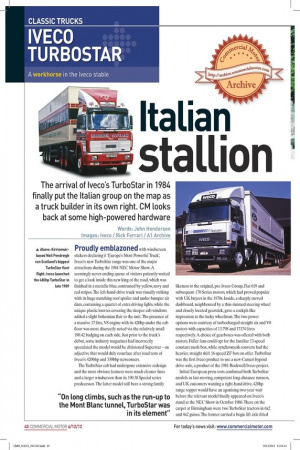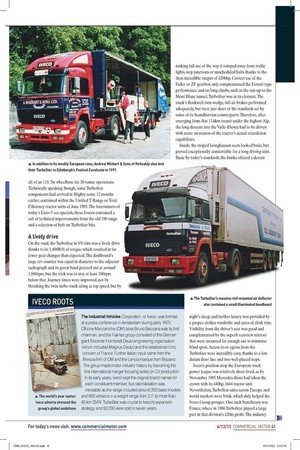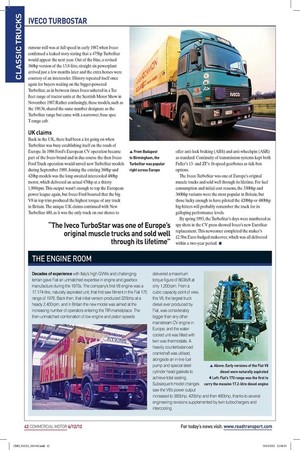Italian stallion
Page 32

Page 33

Page 34

If you've noticed an error in this article please click here to report it so we can fix it.
The arrival of Iveco's TurboStar in 1984 finally put the Italian group on the map as a truck builder in its own right. CM looks back at some high-powered hardware Words: John Henderson / Rick Ferrari /A1 Archive Proudly emblazoned with windscreen stickers declaring it 'Europe's Most Powerful Truck', Iveco's new TurboStar range was one of the major attractions during the 1984 NEC Motor Show. A seemingly never-ending queue of visitors patiently waited to get a look inside this new king of the road, which was finished in a metallic blue, contrasted by yellow, navy and red stripes. The left-hand-drive truck was visually striking with its huge matching roof spoiler and under-bumper air dam, containing a quartet of extra driving lights, while the unique plastic louvres covering the sleeper cab windows added a slight bohemian flair to the unit. The presence of a massive 17-litre, V8 engine with its 420hp under the cab floor was more discreetly noted via the relatively small 190.42 badging on each side. Just prior to the truck's debut, some industry magazines had incorrectly speculated the model would be christened Superstar — an adjective that would duly resurface after road tests of Iveco's 420bhp and 330bhp newcomers.
The TurboStar cab had undergone extensive redesign and the most obvious features were much cleaner lines and a larger windscreen than its 190.38 Special series predecessor. The latter model still bore a strong family likeness to the original, pre-Iveco Group, Fiat 619 and subsequent 170 Series motors, which had proved popular with UK buyers in the 1970s. Inside, a sharply curved dashboard, neighboured by a thin-rimmed steering wheel and closely located gearstick, gave a cockpit-like impression to the lucky wheelman. The two power options were courtesy of turbocharged straight six and V8 motors with capacities of 13.798 and 17.174 litres respectively. A choice of gearboxes was offered with both motors. Fuller fans could opt for the familiar 13-speed constant mesh box, while synchromesh converts had the heavier, straight shift 16-speed ZF box on offer. TurboStar was the first Iveco product to use a new Cameri hypoid drive-axle, a product of the 1981 Rockwell/Iveco project.
Initial European press tests confirmed both TurboStar models as fast-moving, competent long-distance runners, and UK customers wanting a right-hand drive, 420hp range topper would have an agonising two-year wait before the relevant model finally appeared on Iveco's stand at the NEC Show in October 1986. There on the carpet at Birmingham were two TurboStar tractors in 6x2 and 4x2 guises. The former carried a bogie lift axle fitted aft of an 11ft 5in wheelbase for 38-tonne operations. Technically speaking though, some TurboStar components had arrived in Blighty some 12 months earlier, contained within the Unified T Range or Total Efficiency tractor units of June 1985. The forerunners of today's Euro-5 eco specials, these Ivecos contained a raft of technical improvements from the old 190 range and a selection of bolt-on TurboStar bits.
A lively drive On the road, the TurboStar in V8 trim was a lively drive thanks to its 1,4001b/ft of torque, which resulted in far fewer gear changes than expected. The dashboard's large rev counter was equal in diameter to the adjacent tachograph and its green band petered out at around 1,600rpm, but the trick was to stay at least 100rpm below that. Journey times were improved, not by thrashing the twin turbo truck along at top speed, but by making full use of the way it romped away from traffic lights, stop junctions or unscheduled halts thanks to the then-incredible output of 420bhp. Correct use of the Fuller or ZF gearbox only complemented the Ferrari-type performance and on long climbs, such as the run-up to the Mont Blanc tunnel, TurboStar was in its element. The truck's Rockwell twin wedge, full air brakes performed adequately, but were just short of the standards set by some of its Scandinavian counterparts. Therefore, after emerging from that 11.6km transit under the highest Alp, the long descent into the Valle dAosta had to be driven with acute awareness of the tractor's actual retardation capabilities.
Inside, the striped Isringhausen seats looked basic, but proved exceptionally comfortable for a long driving stint. Basic by today's standards, the bunks offered a decent night's sleep, and further luxury was provided by a proper clothes wardrobe and acres of cloth trim. Visibility from the driver's seat was good and complemented by the superb rearview mirrors that were mounted far enough out to minimise blind spots. Access to or egress from the TurboStar were incredibly easy, thanks to a low datum floor line and two well-placed steps.
Iveco's position atop the European truck power league was relatively short-lived, as by November 1985 Mercedes-Benz had taken the crown with its 440hp, 1644 tractor unit. Nevertheless, TurboStar sales across Europe and world markets were brisk, which duly helped the Iveco Group prosper. One such beneficiary was France, where in 1986 TurboStar played a large part in that division's £20m profit. The industry rumour mill was at full speed in early 1987, when Iveco confirmed a leaked story stating that a 475hp TurboStar would appear the next year. Out of the blue, a revised 360hp version of the 13.8-litre, straight six powerplant arrived just a few months later and the extra horses were courtesy of an intercooler. History repeated itself once again for buyers waiting on the bigger-powered TurboStar, as in between times Iveco ushered in a Tec fleet range of tractor units at the Scottish Motor Show in November 1987 Rather confusingly, these models, such as the 190.36, shared the same number designate as the TurboStar range but came with a narrower, base spec T-range cab.
UK claims Back in the UK, there had been a lot going on when TurboStar was busy establishing itself on the roads of Europe. In 1986 Ford's European CV operation became A From Budapest part of the Iveco brand and in due course the then Iveco to Birmingham, the Ford Truck operation would unveil new TurboStar models TurboStar was popular during September 1989. Joining the existing 360hp and right across Europe 420hp models was the long-awaited intercooled 480hp motor, which delivered an actual 476hp at a thirsty 1,900rpm. This output wasn't enough to top the European power league again, but Iveco Ford boasted that the big V8 in top trim produced the highest torque of any truck in Britain. The unique UK claims continued with New TurboStar 480, as it was the only truck on our shores to offer anti-lock braking (ABS) and anti-wheelspin (ASR) as standard. Continuity of transmission systems kept both Fuller's 13and ZF's 16-speed gearboxes as tick-box options.
The Iveco TurboStar was one of Europe's original muscle trucks and sold well through its lifetime. For fuel consumption and initial cost reasons, the 330bhp and 360bhp variants were the most popular in Britain, but those lucky enough to have piloted the 420bhp or 480bhp big-hitters will probably remember the truck for its galloping performance levels.
By spring 1993, the TurboStar's days were numbered as spy shots in the CV press showed Iveco's new EuroStar replacement. This newcomer completed the maker's £2.5bn Euro-badged makeover, which was all delivered within a two-year period. • IVECO ROOTS The Industrial Vehicles Corporation, or Iveco, was formed at a press conference in Amsterdam during early 1975. Off icine Meccaniche (OM) boss Bruno Beccaria was its first chairman, and the Fiat-led group consisted of the German giant Klockner Humboldt Deutz engineering organisation (which included Magirus Deutz) and the established Unic concern of France. Further Italian input came from the Brescia firm of OM and the Lancia marque from Bolzano. The group made motor industry history by becoming the first international merger focusing solely on CV production. In its early years, Iveco kept the original brand names for each constituent member, but rationalisation was inevitable as the range included around 200 basic models and 600 versions in a weight range from 2.7to more than 40-ton GVW. TurboStar was crucial to Iveco's expansion strategy, and 50,000 were sold in seven years.
THE ENGINE ROOM Decades of experience with Italy's high GYVVs and challenging terrain gave Fiat an unmatched expertise in engine and gearbox manufacture during the 1970s. The company's first V8 engine was a 17.174-litre, naturally aspirated unit, that first saw fitment in the Fiat 170 range of 1976. Back then, that initial version produced 325bhp at a heady 2,400rpm, and in Britain the new model was aimed at the increasing number of operators entering the TIR marketplace. The then-unmatched combination of low engine and piston speeds delivered a maximum torque figure of 8631b/ft at only 1,200rpm. From a cubic capacity point of view, this V8, the largest truck diesel ever produced by Fiat, was considerably bigger than any other mainstream CV engine in Europe, and the watercooled unit was fitted with twin wax thermostats. A heavily counterbalanced crankshaft was utilised, alongside an in-line fuel pump and special steel cylinder head gaskets to achieve total sealing. Subsequent model changes saw the V8's power output increased to 380bhp, 420bhp and then 480bhp, thanks to several engineering revisions supplemented by twin turbochargers and intercooling.








































